Talladega Knight
Member
interestingWindu said:oh whoops, i thought he quoted the pic above us, post 394. me=dumb:lol
interestingWindu said:oh whoops, i thought he quoted the pic above us, post 394. me=dumb:lol
Naked Snake said:Is that flowing water, on mars? Sorry for ignorance.
It's not ignorance if you ask.Naked Snake said:Is that flowing water, on mars? Sorry for ignorance.


looks comfy.Subarushian said:Four week stay: 15 million. Start saving.

The Big PictureMissions to planets tend to cause sea changes in thinking. This is especially true the first time you actually touch down. The first spacecraft to land on Mars was Viking 1, on July 20, 1976. The first picture revealed a landscape strewn with rocks.
The search for life beyond Earth had begun in earnest, and the baton of space exploration had been firmly handed off from humans to robots. Much of what's known about Mars today was learned from the Viking missions or from other investigations that built on Viking findings.

Happy TimesThe Hubble Space Telescope was not the first spacecraft to bring Mars into sharp focus, but it did capture one of the best full-globe shots. This image was made during a 1995 opposition, when Mars relatively close to Earth for the same reason it will be close in August 2003.
This photo showed up last year on our list of Top 10 Space Science Photos of all time. Here's what Ray Villard, director for the Space Telescope Science Institute, which operates the telescope, said about it then:
"Looking at pictures of our Red Planet neighbor never grows tiring. The swirling atmosphere is always changing, kicking up dust storms and fleecy white clouds as the planet whirls like a toy top."
While the lack of Martian neighbors has so far been disappointing, the magic of the Red Planet has not died upon close inspection.

The Other FaceThe Viking missions put landers on the planet. But they also mapped Mars from above. One view, of the Argyre basin, stands out in the mind of Bruce Jakosky, an expert on Mars geology from the University of Colorado.
"The perspective, combined with the spectacular impact crater that sits on the rim of Argyre, makes for an incredibly dramatic image," Jakosky said. "I always liked the image, but then somebody ruined it for me by pointing out that this dramatic crater was a perfect reproduction of a Happy Face!"

Live, From Mars!Serious Mars scientists scoff at the idea that the thing in the picture above is a construct of some intelligent civilization. But countless people are utterly convinced that it is, and they accuse NASA of a cover-up. Regardless of how you view the photo, it is big.
Ironically, it was space agency scientists who first suggested the feature had human qualities. Ever since, the face has taken on a life of its own.
Its mere mention in this list will generate e-mails from the believers, some of whom will, not for the first time, implicate SPACE.com in the whole conspiracy. Some will be offended that we've called them believers. Just look at the facts, they'll say.
That's what scientists say, too. And some more facts were provided recently by NASA's Odyssey spacecraft, again showing -- according to the scientists involved in the mission -- that the face is faceless.

3-D ViewsDuring the 1980s and 1990s, space exploration lost some luster for the public. We had stepped on the Moon. Many times. Spacecraft had gone to Mars. Shuttle flights became routine.
On July 4, 1997, Mars Pathfinder and its plucky little Sojourner rover became the first crafts to land on Mars since the Viking era. They beamed home image after image. Most of those pictures would never have been seen by the public were it not for the burgeoning Internet. Millions of people followed the mission's progress online.
Pathfinder took us along, gave us a virtual tour of the Red Planet in real time. As Jakosky puts it: "What better way to show the excitement of exploration and of seeing a new place for the first time.


Night VisionNot all Mars imagery involves photographs, of course. In fact, scientists use other data to create images that fuel much of the best science going.
In the case of this image, data from missions separated by decades were put together to generate the first 3-D view of the north polar region of Mars.
"This is an image of the north pole that we constructed early in the Mars Global Surveyor mission from MOLA [Mars Orbiter Laser Altimeter ] laser shots and color from Viking mosaics," explained Maria Zuber of the Massachusetts Institute of Technology. "It is relatively low resolution but it represented the first three-dimensional perspective of the polar regions of Mars and it has always been one of my favorites."
Ours, too.
The bonus image at right (we just could not stick with 10) is a favorite of David E. Smith, the principal investigator for MOLA at NASA's Goddard Space Flight Center. MOLA data was used to show this 930-mile (1,500-kilometer) stretch of the complex Valles Marineris canyon.
Red shows high areas. Blue regions are the lowest. The canyon has a depth of about 3.7 miles (6 kilometers) on the left and more than 6.2 miles (10 kilometers) at the right side of the image, Smith said. It varies in width from about 62 to 124 miles (100 to 200 kilometers).
Scientists have used MOLA data to get a more accurate view of the planet's surface structure and to figure out where water might once have ponded and where it would have flowed. Artists have used MOLA data to generate computer-reality images of Mars today and in the past, when there might have been surface water.

Parting ShotOne of the most coveted discoveries on Mars, if it ever occurs, will be liquid water. NASA's Odyssey spacecraft came close with the recent finding of water ice under the surface. Odyssey benefits from what was learned by every spacecraft before it, and it succeeded by being a marvel of technological diversity.
Odyssey probably won't be remembered for its Martian photographs, however. Scenes from other orbiting spacecraft have already shown us the entire planet. But Odyssey is giving dramatic (if unconventional) views, including some taken with an infrared camera that will lead to an infrared map of Mars.
This infrared image is among the favorites of Philip Christensen, an Arizona State University geologist in charge of Odyssey's cameras. It shows the entire spring/summer south polar cap.
"Because the image is an infrared image -- the first ever taken of the polar regions of Mars -- one can see details on the night side as well," he said. "The purple colors in the lower right of the image are actually in the dark."
The possibility of liquid water, and maybe even life on Mars, await further investigation that may well be beyond Odyssey's reach.

Mars has not yet coughed up all its secrets. Meanwhile, public interest in Mars and support for the billions of dollars it takes to explore the planet requires refreshment now and then. Many enthusiasts believe that a human mission is the next logical step. Scientists say it's the only way we'll answer the most pressing questions.
The trip will be dangerous.
Even getting good pictures of Mars is expensive and risky. Not every mission makes it -- only about half, history shows.
This final photo is one of the very few images of Mars taken by the Mars Observer, which was lost three days before it was to arrive at the planet in 1993. This shot, Observer's last, was taken about a month before the disaster and was used to calibrate instruments on the spacecraft. The target planet seems to emerge from the darkness in a photo that is haunting in more ways than one.
While the picture is not remarkable in any traditional sense, it stands as an important reminder that while technology has brought us closer to Mars, the planet is still not an easy target. This very challenge allows Mars to retain puzzles, fueling the human desire to go all the more.
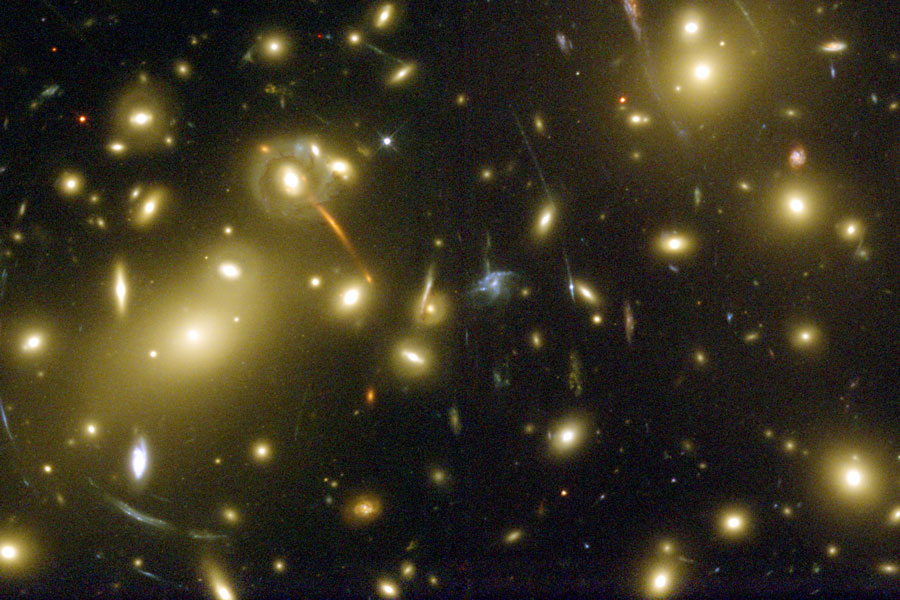
Explanation: Gravity can bend light, allowing huge clusters of galaxies to act as telescopes. Almost all of the bright objects in this Hubble Space Telescope image are galaxies in the cluster known as Abell 2218. The cluster is so massive and so compact that its gravity bends and focuses the light from galaxies that lie behind it. As a result, multiple images of these background galaxies are distorted into long faint arcs -- a simple lensing effect analogous to viewing distant street lamps through a glass of wine. The cluster of galaxies Abell 2218 is itself about three billion light-years away in the northern constellation of the Dragon (Draco). The power of this massive cluster telescope has allowed astronomers to detect a galaxy at redshift 5.58, the most distant galaxy yet measured. This young, still-maturing galaxy is faintly visible to the lower right of the cluster core.

Rho Oph is made up of a large main cloud of molecular hydrogen, a key molecule allowing new stars to form out of cold cosmic gas, with two long streamers trailing off in different directions. Recent studies using the latest X-ray and infrared observations reveal more than 300 young stellar objects within the large central cloud. Their median age is only 300,000 years, very young compared to some of the universe's oldest stars, which are more than 12 billion years old.
fallout said:Stellar nurseries are so fucking cool. I just find it so beautiful that (in general) stars explode, creating nebula, which then create more stars. It's incredible!
Subarushian said:And those first stars when they exploded seeded the rest of the galaxy with heavy elements allowing rocky planets to form around new stars.
Every molecule in your body was first "prototyped" and made in the heart of an ancient star.
Yep. And all the heavy elements that you see around you most likely came from a nearby supernova billions of years ago. Of course, everything you see around you (and more) was once an infinitesimally small point ... kind of depends on which perspective you wish to take (or, I guess, how far back you wish to go).dark_chris said:Brain explodes.
fallout said:... what? Why are you shitting up this wonderful thread.

Basically, you've got a bunch of geostationary satellites, which are the points and all the streaks are stars and other stuff that moves relative to the rotation of the earth.This long-exposure photograph taken on January 3, 2001, shows nearly two dozen space satellites hovering over Kitt Peak, AZ, southwest of Tucson. Nineteen commercial communications satellites in the image have been clearly identified using location data on the Internet. The reddish Orion Nebula and the bright star Rigel, among others, are visible as bright streaks due to the rotation of Earth during the exposure. Amateur photographer Bill Livingston, a staff scientist with the National Science Foundation's National Solar Observatory near Tucson, took the image using basic camera equipment.
Needed to be quoted again, so beautiful.Subarushian said:

Karakand said:Have a higher res version of that Europa pic, Arthas?
Also bless this thread.

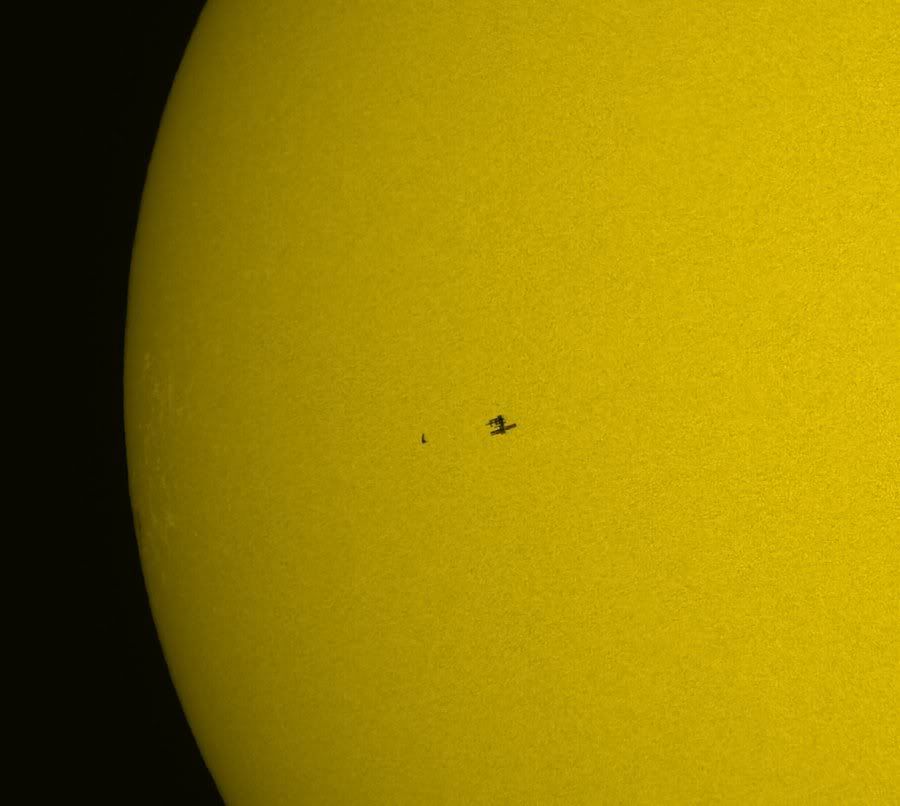

OMG it charging its Lazer 0_OWindu said:
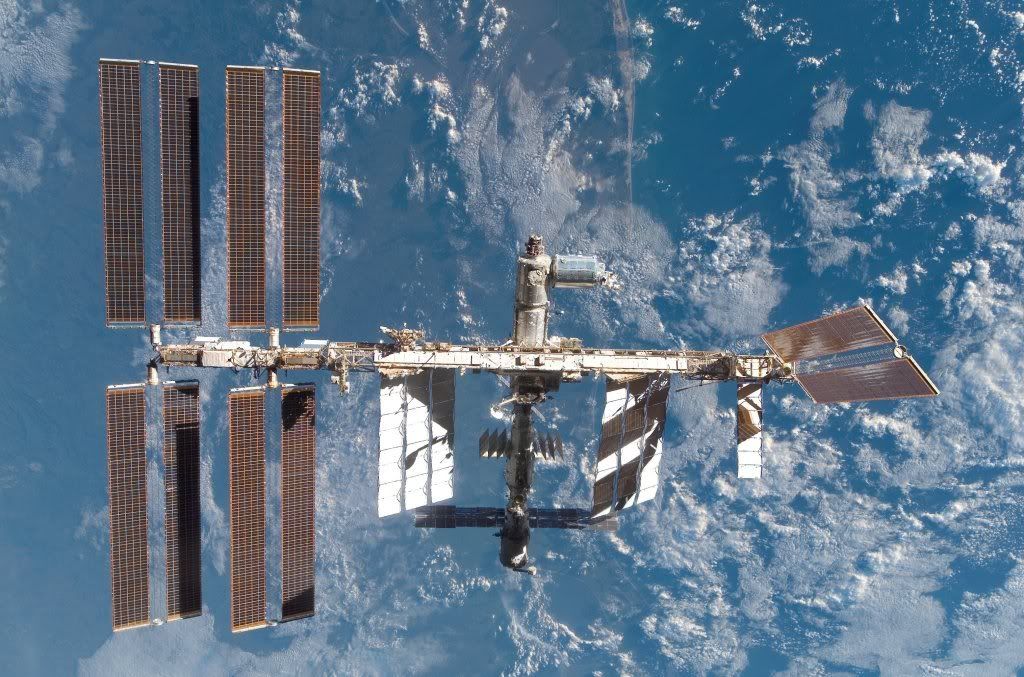

STS-122 pilot Alan Poindexter and commander Steve Frick look out of the starboard window (pilot's side) of space shuttle Atlantis while it was docked to the International Space Station.
The two watched as fellow crewmates Rex Walheim and Stan Love perform the third and last spacewalk of the mission.
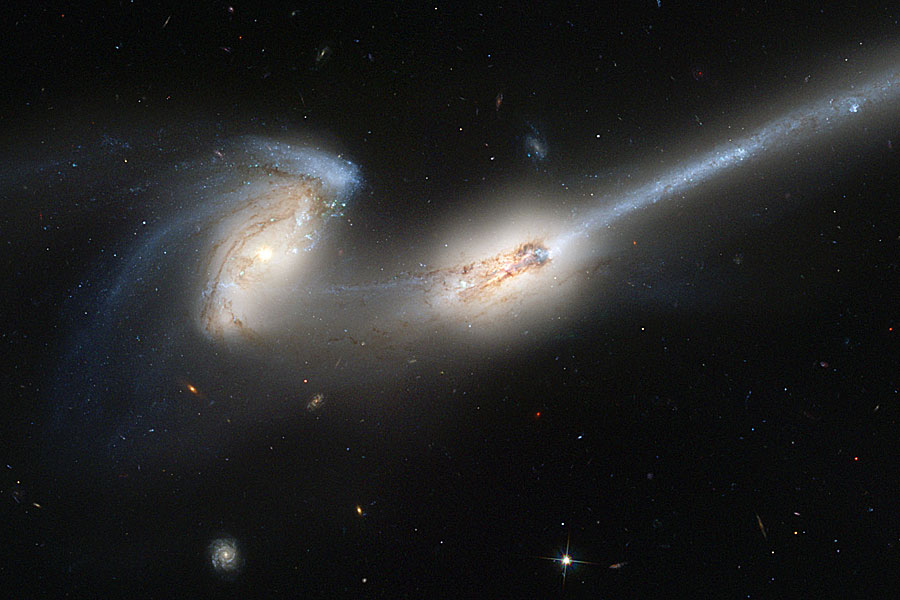
http://antwrp.gsfc.nasa.gov/apod/ap080224.htmlExplanation: These two mighty galaxies are pulling each other apart. Known as " The Mice" because they have such long tails, each spiral galaxy has likely already passed through the other. They will probably collide again and again until they coalesce. The long tails are created by the relative difference between gravitational pulls on the near and far parts of each galaxy. Because the distances are so large, the cosmic interaction takes place in slow motion -- over hundreds of millions of years. NGC 4676 lies about 300 million light-years away toward the constellation of Bernice's Hair (Coma Berenices) and are likely members of the Coma Cluster of Galaxies. The above picture was taken with the Hubble Space Telescope's Advanced Camera for Surveys which is more sensitive and images a larger field than previous Hubble cameras. The camera's increased sensitivity has imaged, serendipitously, galaxies far in the distance scattered about the frame.
michaeld said:
Tideas said:why isn't there stars in the bg?
ConfusingJazz said:Camera settings and the sunlight.
Subarushian said:Full:

Teknoman said:Yes! It has returned!
Thats just...wow. But why does the sun look so docile?
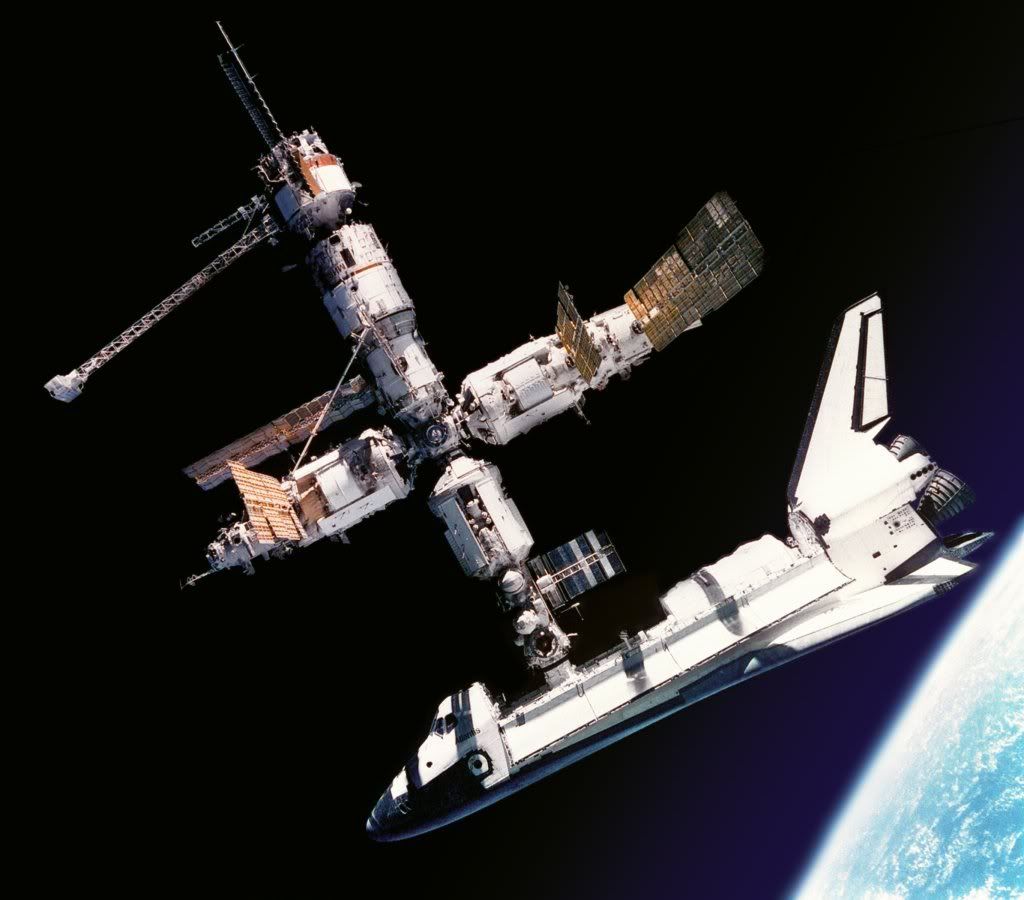
Teknoman said:Yes! It has returned!
Thats just...wow. But why does the sun look so docile?
Tideas said:I think that's earth. the blackdot is the spacestation
Subarushian said:Breaking the sound barrier
The Space Shuttle and the ISS backdropped by the sun:

Full:

It's actually really simple. They wanted to take pictures of the earth, other astronauts, the moon, but not the stars. Remember, the sun is actually shining on the earth and the moon in these pictures. Naturally, then, they're taking short exposures. Take a fast exposure of the night sky and tell me what happens.Tideas said:why isn't there stars in the bg?
Just a solar filter. Basically, as far as I know, it's just a mirror. There are different filters you can use, though, like Hα, which show the really cool features like prominences and stuff. We used the former in my first year astronomy class to study the rotational speed of the Sun (yes, it's spinning) by tracking the sunspots. In fact, you can see a sunspot way up on the top right there. Right now, the Sun is in its low period for sunspots (they work on an 11 year cycle), so that's why there aren't more.Teknoman said:Thats just...wow. But why does the sun look so docile?
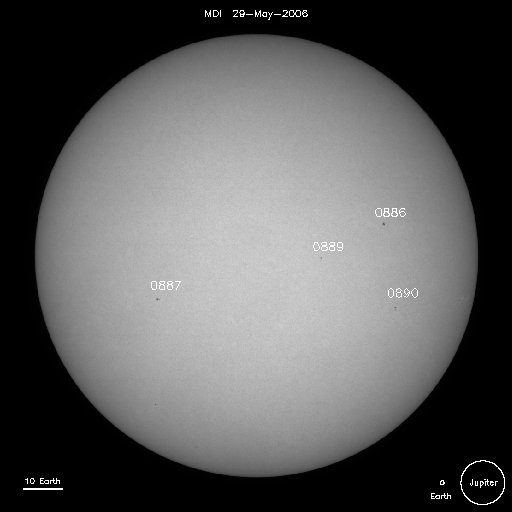
Please tell me someone has that in HiRes?Windu said:Needed to be quoted again, so beautiful.
Arthas said:Icy Europa:

JetSetHero said:Holy fucking shit - are those real? Surely not!
Image of the solar transit of the International Space Station (ISS) and Space Shuttle Atlantis (50 minutes after undocking from the ISS, before return to Earth), taken from the area of Mamers (Normandie, France) on september 17th 2006 at 13h 38min 50s UT.
Takahashi TOA-150 refractor (diameter 150mm, final focal 2300mm), Baader helioscope and Canon 5D. Exposure of 1/8000s at 50 ISO, extracted from a series of 14 images (3 images/s) started 2s before the predicted time.
Transit forecast (place, time...) calculated by www.calsky.com.
Transit duration: 0,6s. Transit band width on Earth: 7.4 km. ISS distance to observer: 550 km. Speed: 7.4km/s. ISS size: 73m. Distance between ISS and Atlantis: 200m

Please tell me someone has that in HiRes?
fallout said:APOD revives the thread again! Interacting galaxies are just so fucking cool. There are a bunch of galaxy interaction programs out there that you can use to simulate galaxy collisions. It's sort of relaxing to play around with them ... in a weird sort of way.
http://antwrp.gsfc.nasa.gov/apod/ap080224.html
Have I mentioned how much I love this thread? Damn those are some nice shots.Windu said:surreal awesomeness
